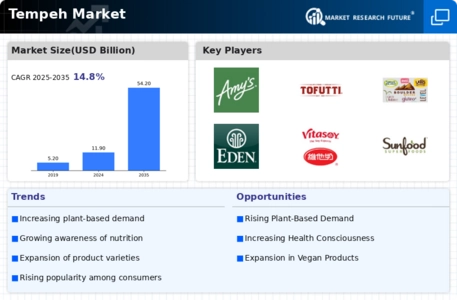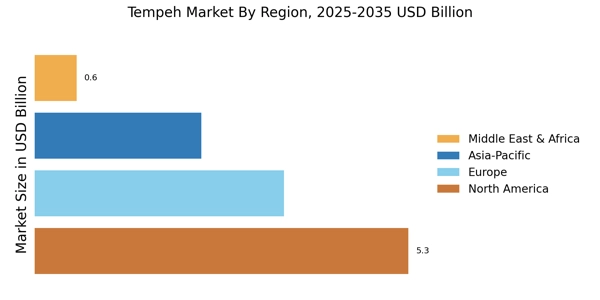Ethical Consumerism
The rise of ethical consumerism is playing a crucial role in shaping the Tempeh Market. Consumers are increasingly making purchasing decisions based on ethical considerations, such as animal welfare and fair trade practices. Tempeh Market, being a plant-based product, aligns with the values of those who prioritize humane and ethical food sources. This trend is particularly evident among younger demographics, who are more likely to support brands that reflect their ethical beliefs. As a result, companies within the Tempeh Market are likely to emphasize their commitment to ethical sourcing and production methods, which could enhance brand loyalty and consumer trust. This shift towards ethical consumption is expected to bolster the growth of the tempeh market as more individuals seek products that resonate with their values.
Culinary Versatility
The culinary versatility of tempeh is emerging as a significant driver for the Tempeh Market. Chefs and home cooks alike are discovering the myriad ways in which tempeh can be incorporated into various cuisines. Its ability to absorb flavors and its firm texture make it suitable for a wide range of dishes, from stir-fries to salads and sandwiches. This adaptability is likely to attract a diverse consumer base, including those who may not typically consider plant-based options. Furthermore, the rise of cooking shows and social media platforms showcasing innovative tempeh recipes is contributing to its popularity. As culinary trends evolve, the Tempeh Market may see an increase in demand as more individuals experiment with this versatile ingredient in their cooking.
Health Consciousness
The increasing awareness of health and nutrition among consumers appears to be a pivotal driver for the Tempeh Market. As individuals seek healthier dietary options, the demand for plant-based proteins, such as tempeh, has surged. Tempeh Market is recognized for its high protein content, essential amino acids, and probiotic benefits, making it an attractive alternative to traditional meat products. According to recent data, the plant-based protein segment is projected to grow at a compound annual growth rate of over 10% in the coming years. This trend indicates that consumers are not only looking for meat substitutes but are also prioritizing foods that contribute positively to their health. Consequently, the Tempeh Market is likely to experience sustained growth as more individuals incorporate tempeh into their diets.
Environmental Sustainability
The growing emphasis on environmental sustainability is significantly influencing the Tempeh Market. As consumers become increasingly aware of the environmental impact of meat production, many are shifting towards plant-based alternatives. Tempeh Market, being a fermented soy product, has a lower carbon footprint compared to animal-based proteins. Research suggests that the production of tempeh requires fewer natural resources, such as water and land, which aligns with the values of eco-conscious consumers. This shift towards sustainable eating habits is expected to drive the demand for tempeh, as it is perceived as a more environmentally friendly option. The Tempeh Market is thus positioned to benefit from this trend, as more consumers seek to reduce their ecological impact through dietary choices.
Increased Availability and Accessibility
The increased availability and accessibility of tempeh products are driving growth in the Tempeh Market. Retailers are expanding their plant-based offerings, making tempeh more accessible to consumers. Supermarkets, health food stores, and online platforms are increasingly stocking a variety of tempeh products, catering to the rising demand. This trend is supported by data indicating that the plant-based food market is expected to reach a valuation of several billion dollars in the next few years. As consumers encounter tempeh more frequently in their shopping experiences, they are likely to be more inclined to try it. This enhanced accessibility is crucial for the Tempeh Market, as it may lead to increased consumption and a broader acceptance of tempeh as a staple protein source.


















Leave a Comment